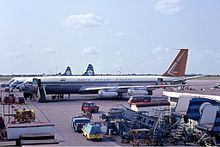Passengers 116 Fatalities 123 Aircraft type Boeing 707-344C Number of deaths 123 Survivor 5 | Crew 12 Survivors 5 Date 20 April 1968 Passenger count 116 | |
 | ||
Similar Pan Am Flight 217, Air France Flight 212, 1968 Kham Duc C‑130 shootdown, Braniff Flight 352, El Al Flight 253 attack | ||
South African Airways Flight 228 was a scheduled flight from Jan Smuts International Airport in Johannesburg, South Africa to London Heathrow International Airport that flew into the ground soon after take-off after a scheduled stopover in Windhoek, South West Africa (present day Namibia). Five passengers survived while 123 people died. The subsequent investigation determined that the accident was attributable largely to pilot error; the manufacturer subsequently also recognised the lack of a ground proximity warning system in its aircraft. The accident is the deadliest aviation accident to date in Namibia.
Contents
History of the flight
South African Airways Flight 228 was a scheduled flight of the Boeing 707-300C Pretoria, registration ZS-EUW, on 20 April 1968 from Johannesburg to Heathrow via Windhoek, Luanda, Las Palmas and Frankfurt.
The first leg of the flight under Captain Eric Ray Smith from Johannesburg to JG Strijdom Airport, Windhoek, South West Africa was uneventful. An additional 46 passengers embarked in Windhoek, and some airfreight was unloaded and loaded. The aircraft was only 6 weeks old when it rolled for take-off from Windhoek on runway 08 at 18:49 GMT (20:49 local time). It was a dark, moonless night with few if any lights on the ground in the open desert east of the runway; the aircraft took off into what was described in the official report as a "black hole". The aircraft initially climbed to an altitude of 650 feet (200 m) above ground level, then levelled off after 30 seconds and started to descend.
Fifty seconds after take-off, it flew into the ground in flight configuration at a speed of approximately 271 knots (502 km/h). The four engines, which were the first parts of the aircraft to touch the ground, created four gouges in the soil before the rest of the aircraft also hit the ground and broke up. Two fires immediately broke out when fuel in the wings ignited. Although the crash site was only 5,327 metres (17,477 ft) from the end of the runway, emergency services took 40 minutes to reach the scene because of rugged terrain. Nine passengers who were seated in the forward section of the fuselage initially survived, but two died soon after the accident, and another two a few days later, leaving a final death toll of 123 passengers and crew.
Investigation
The investigation was complicated by the fact that the aircraft did not have a flight data recorder or cockpit voice recorder; the devices became mandatory from 1 January 1968, but the airline's inability to procure recorders meant that several SAA aircraft, including ZS-EUW, did not yet have the equipment fitted. Captain Smith had 4,608 flying hours on the Boeing 707, but only one hour on the new type 344C, which furthermore had been under instruction. The official investigation concluded that the aircraft and its four engines were in working order—primary fault lay with the captain and first officer, in that they "failed to maintain a safe airspeed and altitude and a positive climb by not observing flight instruments during take-off"; no blame was attributed to the third pilot, whose responsibility it was to monitor the radio, and who was unable to monitor the flight instruments from his position in the cockpit. Secondary factors that may have contributed to the accident included:
After investigating this accident as well as a number of others that also involved controlled flight into terrain, the Federal Aviation Administration determined that a ground proximity warning system would have helped to avert some of the accidents. New regulations were therefore introduced from February 1972 requiring all turbojet aircraft to be fitted with the system.
